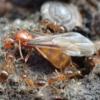Wait, does this mean that both T. caespitum and Tetramorium sp.E are being renamed, or just sp. E?
Tetramorium sp. E was treated as loosely synonymous with Tetramorium caespitum, but this shows that our most common Tetramorium are actually something else, T. immigrans, a taxa which has been revived from obsoletion. Tetramroium caespitum is still a valid species, but not what we have in North America.
-
gcsnelling, LC3, BMM and 1 other like this
If you've enjoyed using my expertise and identifications, please do not create undue ecological risk by releasing your ants. The environment which we keep our pet insects is alien and oftentimes unsanitary, so ensure that wild populations stay safe by giving your ants the best care you can manage for the rest of their lives, as we must do with any other pet.
Exotic ants are for those who think that vibrant diversity is something you need to pay money to see. It is illegal to transport live ants across state lines.
----
Black lives still matter.















